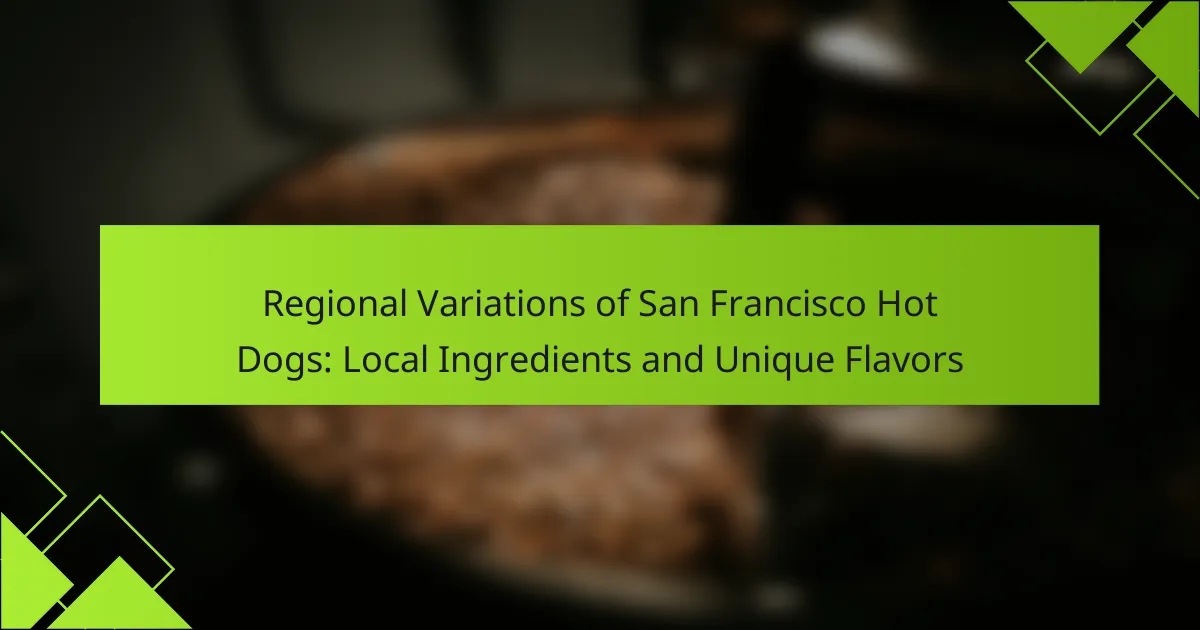San Francisco hot dogs represent a unique culinary entity characterized by regional variations that reflect local ingredients and culinary traditions. Key styles include the classic hot dog with a sourdough bun, the garlic hot dog featuring garlic-infused sausage, and the Dungeness crab hot dog that incorporates local crab meat. Popular toppings range from spicy mustard and pickled jalapeños to avocado and salsa, showcasing the city’s diverse flavors. To explore these variations, visitors can attend local food festivals, sample offerings from various vendors, and engage with local chefs, providing insight into San Francisco’s distinct hot dog scene.

What are the Regional Variations of San Francisco Hot Dogs?
San Francisco hot dogs exhibit regional variations influenced by local ingredients and culinary traditions. These variations include the use of unique toppings and styles. For instance, the classic San Francisco hot dog often features a sourdough bun. This bun is a nod to the city’s iconic bread culture. Additionally, toppings may include spicy mustard, pickled jalapeños, and grilled onions.
Another variation is the “Mission-style” hot dog, which incorporates avocado and salsa. This reflects the vibrant flavors of the Mission District. Furthermore, seafood toppings like clam chowder or crab are popular near the waterfront. These variations highlight the city’s diverse culinary landscape. Each regional style showcases local flavors and ingredients, making San Francisco hot dogs distinct.
How do local ingredients influence the flavor of San Francisco hot dogs?
Local ingredients significantly enhance the flavor of San Francisco hot dogs. The city’s diverse culinary landscape incorporates fresh, locally sourced produce and artisanal condiments. For example, the use of sourdough bread for buns adds a distinct tanginess. Additionally, local toppings like pickled vegetables and specialty mustards provide unique flavor profiles. The proximity to the Pacific Ocean allows for the inclusion of fresh seafood options, such as clam chowder as a topping. This integration of local flavors reflects San Francisco’s rich food culture. The emphasis on quality and freshness elevates the overall taste experience of the hot dogs.
What specific local ingredients are commonly used in these variations?
Common local ingredients used in San Francisco hot dog variations include sourdough bread, local artisan sausages, and fresh produce. Sourdough bread is a staple in San Francisco, adding a unique flavor profile. Artisan sausages often feature local meats and spices, enhancing the overall taste. Fresh produce such as avocados, tomatoes, and peppers are frequently used for toppings. These ingredients reflect the region’s culinary traditions and local agriculture. The inclusion of these elements creates a distinctive hot dog experience unique to San Francisco.
How do these ingredients differ from traditional hot dog components?
The ingredients of San Francisco hot dogs differ from traditional hot dog components primarily in their local sourcing and flavor profiles. Traditional hot dogs typically consist of processed meats, such as beef or pork, and common condiments like mustard and ketchup. In contrast, San Francisco hot dogs often incorporate locally sourced ingredients like artisan sausages, fresh vegetables, and unique toppings such as avocado or spicy aioli.
This regional variation reflects the city’s culinary culture, emphasizing fresh, high-quality components. For instance, the use of Dungeness crab meat in some hot dog recipes highlights local seafood availability. Additionally, the inclusion of gourmet toppings elevates the flavor experience beyond standard fare. These differences result in a distinct taste and texture, showcasing the creativity of San Francisco’s food scene.
What unique flavors can be found in San Francisco hot dogs?
San Francisco hot dogs feature unique flavors such as garlic, jalapeño, and smoked paprika. These ingredients reflect the city’s diverse culinary influences. Local vendors often incorporate gourmet toppings like kimchi and aioli. Additionally, many hot dogs are served with fresh, locally sourced vegetables. The use of artisan buns adds to the flavor profile. Specialty sausages, including chicken and vegan options, are also popular. These variations highlight San Francisco’s innovative food scene. The city’s hot dog offerings are a blend of tradition and modern culinary creativity.
How do regional culinary traditions shape these unique flavors?
Regional culinary traditions shape unique flavors by incorporating local ingredients and cooking methods. In San Francisco, hot dogs are influenced by the city’s diverse cultural heritage. For instance, the use of sourdough bread reflects the region’s baking traditions. Local seafood, like Dungeness crab, adds a distinct coastal flavor. Additionally, spices and seasonings from immigrant communities enhance the overall taste profile. These traditions create a fusion of flavors that are specific to the region. Historical migration patterns have also contributed to these culinary influences. Thus, regional traditions play a crucial role in defining the unique flavors of San Francisco hot dogs.
What are some popular flavor combinations in San Francisco hot dogs?
Popular flavor combinations in San Francisco hot dogs include garlic aioli and roasted peppers. Another favorite is kimchi and sriracha, offering a spicy kick. Additionally, many enjoy toppings like pickled onions and jalapeños for added zest. Local ingredients such as Dungeness crab and avocado are also common in gourmet variations. These combinations reflect the city’s diverse culinary influences. Food vendors and restaurants often experiment with unique toppings to create signature styles. San Francisco’s hot dog scene showcases both traditional and innovative flavors.

What are the Most Popular Styles of San Francisco Hot Dogs?
The most popular styles of San Francisco hot dogs include the classic hot dog, the garlic hot dog, and the Dungeness crab hot dog. The classic hot dog is often served with mustard, onions, and sauerkraut. The garlic hot dog features a garlic-infused sausage, providing a distinct flavor. The Dungeness crab hot dog incorporates fresh crab meat, a local specialty. These styles reflect the city’s culinary diversity and use of local ingredients. San Francisco hot dogs are often enjoyed at street fairs and food trucks, showcasing their popularity in the region.
How do different neighborhoods in San Francisco influence hot dog styles?
Different neighborhoods in San Francisco influence hot dog styles through local ingredients and cultural preferences. For instance, the Mission District is known for its Mexican influence, leading to hot dogs topped with jalapeños and salsa. In contrast, Fisherman’s Wharf features seafood-inspired hot dogs, often garnished with clam chowder. The Haight-Ashbury area promotes vegetarian and vegan options, reflecting its counterculture roots. Chinatown offers hot dogs with Asian flavors, incorporating ingredients like teriyaki sauce and kimchi. Each neighborhood’s unique demographic and culinary traditions shape the hot dog variations found there. This diversity showcases San Francisco’s rich cultural tapestry and its impact on local cuisine.
What are the signature styles of hot dogs in specific neighborhoods?
Signature styles of hot dogs vary significantly across San Francisco neighborhoods. In the Mission District, the hot dogs often feature local ingredients like avocado and chipotle mayo. The Haight-Ashbury area is known for its gourmet hot dogs topped with unique items such as kimchi and sriracha. In Fisherman’s Wharf, seafood-infused hot dogs with clam chowder toppings are popular. The Tenderloin showcases hot dogs with bold flavors, often including spicy jalapeños and pickled onions. Each neighborhood’s hot dog style reflects its culinary influences and local culture.
How do local culture and events impact hot dog offerings?
Local culture and events significantly influence hot dog offerings. Regional festivals often showcase unique ingredients. For example, San Francisco’s street fairs may feature local seafood toppings. Cultural diversity in the area leads to varied flavor profiles. Hot dogs can be topped with items like kimchi or gourmet sauces. Seasonal events also inspire limited-time offerings. For instance, a local harvest festival might promote farm-fresh produce as toppings. Overall, local culture and events shape the creativity and variety in hot dog menus.
What role do food trucks and street vendors play in hot dog variations?
Food trucks and street vendors significantly influence hot dog variations. They introduce diverse toppings and styles that reflect local culture. For example, San Francisco vendors often incorporate ingredients like avocado and artisanal sauces. This creates unique flavor profiles distinct to the region. Additionally, food trucks adapt to consumer trends, offering gourmet versions or fusion recipes. Their mobility allows them to experiment with seasonal ingredients. This dynamic approach enhances the overall hot dog experience. Vendors often showcase local culinary traditions, making hot dogs a canvas for regional creativity.
How do food trucks innovate traditional hot dog recipes?
Food trucks innovate traditional hot dog recipes by incorporating local ingredients and unique flavor combinations. They often source fresh produce and artisanal products from nearby farmers’ markets. This practice enhances the quality of the hot dogs and aligns with the farm-to-table movement. Food trucks also experiment with diverse toppings, such as kimchi, avocado, or gourmet cheeses. These toppings reflect cultural influences and regional preferences. Additionally, food trucks may offer specialty sausages made from unconventional proteins like duck or lamb. This variety caters to different dietary preferences and expands the traditional hot dog concept. Overall, food trucks redefine hot dog offerings by blending creativity with local culinary traditions.
What are the most popular food truck hot dog styles in San Francisco?
The most popular food truck hot dog styles in San Francisco include the classic California-style hot dog, the gourmet artisan hot dog, and the international fusion hot dog. California-style hot dogs often feature fresh toppings like avocado, salsa, and sprouts. Gourmet artisan hot dogs emphasize high-quality meats and unique flavor combinations, such as truffle aioli or kimchi. International fusion hot dogs incorporate flavors from various cuisines, such as Mexican or Asian influences. These styles reflect San Francisco’s diverse culinary landscape and local ingredient availability. Food trucks often rotate their offerings, keeping the hot dog scene dynamic and innovative.

How Can You Experience Regional Variations of San Francisco Hot Dogs?
To experience regional variations of San Francisco hot dogs, visit local food festivals and markets. These events often showcase unique styles and ingredients. Explore neighborhoods known for their culinary diversity, such as the Mission District or Chinatown. Sample hot dogs from various vendors to taste different flavor profiles. Look for specialty shops that offer locally sourced toppings and condiments. Attend food tours that focus on regional street food. Engage with local chefs who can share their interpretations of hot dogs. Each of these methods provides a distinct perspective on the regional flavors and ingredients that define San Francisco’s hot dog scene.
What are the best places to try these unique hot dogs?
The best places to try unique hot dogs in San Francisco include Rosamunde Sausage Grill, known for its diverse selection of sausages. Another top spot is The Dog House, which offers gourmet hot dogs with local ingredients. Additionally, the Golden Gate Park’s Food Trucks feature various vendors specializing in unique hot dog creations. Each of these locations is celebrated for their innovative flavors and quality ingredients, making them must-visit spots for hot dog enthusiasts.
How do you identify authentic San Francisco hot dog vendors?
Authentic San Francisco hot dog vendors can be identified by specific characteristics. They typically use high-quality, locally sourced ingredients. Many vendors offer unique toppings that reflect the city’s diverse culinary scene. Authentic vendors often have a distinctive cart design, often featuring vibrant colors and local branding. They may also have a presence at popular local events or festivals. Additionally, authentic vendors are known for their commitment to traditional preparation methods. Many have been operating in the city for several years, establishing a loyal customer base. Engaging with customers and providing a memorable experience is also a hallmark of genuine vendors.
What tips can enhance your experience of tasting San Francisco hot dogs?
To enhance your experience of tasting San Francisco hot dogs, focus on local ingredients and unique flavors. Seek out vendors that offer specialty toppings like garlic aioli or pickled vegetables. Pair the hot dog with a local craft beer for a complementary taste experience. Consider trying different types of sausages, such as the popular Dungeness crab sausage, which reflects the region’s seafood heritage. Enjoy your hot dog at iconic locations like AT&T Park for a vibrant atmosphere. Sampling from various food trucks can also expose you to diverse flavor profiles. Always ask for recommendations from locals to discover hidden gems.
How can pairing drinks elevate the hot dog tasting experience?
Pairing drinks can elevate the hot dog tasting experience by enhancing flavors and providing balance. The right beverage can complement the spices and toppings of a hot dog. For example, a crisp lager can cut through the richness of a chili dog. Similarly, a fruity soda can contrast nicely with a spicy sausage. This interaction can make each bite more enjoyable. Studies show that pairing food and drink can improve overall satisfaction. According to the Journal of Food Science, complementary flavors can enhance taste perception. Thus, thoughtful drink pairings can transform a simple hot dog into a gourmet experience.
What are some common mistakes to avoid when trying regional hot dogs?
One common mistake to avoid when trying regional hot dogs is not understanding the local toppings. Different regions have unique ingredients that define their hot dogs. For example, Chicago-style hot dogs include toppings like mustard, onions, and pickles. Another mistake is overlooking the type of sausage used. Each region may have a specific sausage that enhances its flavor profile. Not paying attention to the preparation method is also a common error. Some hot dogs are grilled, while others are steamed or boiled. Additionally, failing to pair the hot dog with the right beverage can diminish the experience. For instance, a craft beer often complements a gourmet hot dog well. Lastly, not considering the regional context can lead to misunderstandings about flavor combinations. Each regional hot dog tells a story of local culture and preferences.
The main entity of the article is San Francisco hot dogs, which showcase regional variations influenced by local ingredients and culinary traditions. The article explores the unique toppings and styles that define these hot dogs, such as the classic sourdough bun, Mission-style with avocado, and seafood options near the waterfront. It highlights how local ingredients enhance flavor profiles, differentiating San Francisco hot dogs from traditional counterparts. Additionally, the influence of neighborhoods on hot dog styles, the role of food trucks, and tips for experiencing these regional variations are discussed, providing a comprehensive overview of the city’s distinctive hot dog culture.
